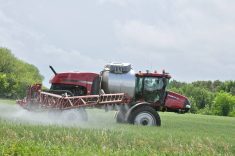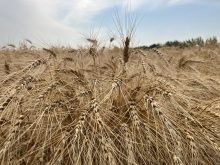Fusarium has been found across Europe with half the wheat intended for human consumption containing vomitoxin
Fusarium mycotoxins are a growing threat to wheat. A recent study conducted by scientists at the University of Bath and colleagues at the University of Exeter in the United Kingdom has resulted in the most complete profile yet of the mycotoxin threat.
Researchers examined data from across Europe and the U.K. from the past 10 years and found that fusarium mycotoxins were discovered in every European country with half of the wheat intended for human consumption containing the fusarium mycotoxin DON (often referred to as vomitoxin). In the U.K., 70 percent of wheat was contaminated with DON.
Read Also

VIDEO: Catch up with the Western Producer Markets Desk
The Western Producer Markets Desk provides daily updates on agricultural markets, with recent video commentary including looks into canola, wheat, cattle and feed grains.
“Through conversations with key stakeholders and funding bodies, I felt there was a misconception of the scale and the continued threat posed to safe cereal production by fusarium head blight (FHB),” said Neil Brown, molecular fungal biologist, at the department of life sciences, University of Bath. “The lack of a monitoring system and the frequency and severity of FHB pathogens throughout Europe hindered our ability to document FHB’s impact. But what we did have was a robust mycotoxin testing network in food (EFSA) and feed (BIOMIN world mycotoxin survey).”
With that information, they were able to get a better understanding of how the fungal infection threatens safe food and feed production as well as get an estimate of the economic impact for the disease.
While regulations provide sufficient protection to allow 95 percent of wheat destined for human consumption to meet safety limits for DON concentration, the fact that mycotoxins are so ubiquitous is a worry because the health impact of that long-term, low-level exposure to dietary mycotoxins is not known.
Wheat is central to global food production, providing 18 percent of the total calories in people’s diets. But it was the long-term concern for health that drove the study, with concerning results.
“Since 2000, FHB incidence has increased in the U.K. from around 30 percent to 60-70 percent of wheat fields having FHB symptoms,” said Brown. “This type of FHB disease incidence data from European fields was missing and this is why we turned to mycotoxin data as a proxy measurement of the disease and the changing threat levels.”
While 70 percent of U.K. wheat contained DON, most was below the safe food threshold. Even so, Brown agreed that a constant low-level exposure is concerning not just to the presence of FHB but multiple different mycotoxins, the impacts of which, he said, are poorly understood.
“While the far greater exposure of livestock and poultry to mycotoxins is known to have direct impacts on animals’ weight gain or egg production, the economic impacts can be very diverse and difficult to quantify.”
Putting a price on FHB mycotoxins resulted in some sobering numbers.
“Across Europe, we estimate that 75 million tonnes of wheat (five percent of food wheat) exceeded the limit allowed for human consumption between 2010 and 2019,” said Louise Johns, a PhD student. “Downgrading this to animal feed equates to a loss of around 3,000 million Euros over the last 10 years.”
The reasons for the stubborn spread of mycotoxins are many.
“Changing climates and agricultural practices will obviously impact on fungal pathogen infection cycles and mycotoxins,” said Brown. “Reduced plowing to preserve soil health results in more stubble being left in the field, which acts as a reservoir for the pathogen. Warmer winters can help higher amounts of the pathogen survive in crop residue. There has been an increase in the cultivation of corn, which is highly susceptible to FHB, which also increased regional level disease pressure.”
In addition, he said that wet periods around crop flowering increase the risk of infection while wet periods around harvesting can delay crop drying and give more time for mycotoxin contamination to occur. Optimum summer temperatures also play into the mix. In the U.K. they are getting closer to the optimum range for fusarium growth, infection, and mycotoxin production with a range from 25 to 28 C.
“There are many variables and we do not have the right data on FHB incidence and local climate plus farming practices to successfully answer this question (of causes) yet,” he said. “But it is on our to-do list.”
Complexities may arise when mycotoxins within plant-based foods survive the cooking and brewing processes to make it to the end product still in a toxic form. When consumed by livestock, the toxins are found in meat, eggs and milk at low levels. But Brown said that masked mycotoxins are a particular concern because they can convert into other forms and may not then be detected.
“For example, DON can be converted into DON-3-glucoside (less toxic than DON) in plants, which might not always be tested for,” he said. “And intestinal bacteria have been shown to convert this masked form back into DON so our dietary exposure could be higher than we expect.”
He said that, in animals, DON can be converted into non-toxic de-epoxide derivative DOM-1. This can influence steroid production and apoptosis, or programmed cell death in bovine ovaries, which may indicate it is more biologically active than thought. This is currently an expanding area of research.
Getting ahead of FHB mycotoxins means preventing them from infecting wheat during the flowering period.
“To achieve this, there are two recommended approaches that are used together: plant resistance and fungicides,” said Brown. “However, (while) the partial resistance used prevents significant spread of infection throughout the plant, it does not prevent multiple infections and mycotoxin production. Then there are difficulties in controlling FHB with our current fungicides as some fusarium pathogens are intrinsically more resistant to common fungicides (azoles) than other fungi.”
He added that it is also difficult to protect all wheat heads growing in the field as they are emerging and flowering at different times, leaving some plants unprotected.
“You don’t need too many to be infected for the mycotoxins to make it into the harvest. This is why we need more research into better crop resistance and new agrochemicals to combat FHB.”
Going forward, the research will first focus on a better understanding of how communities of fusarium pathogens are adapting to the changing climate and changing agricultural practices, exactly what this means for the future, and how best to mitigate impacts. Secondly, the research team is studying how fusarium pathogens sense their environment and turn on and off mycotoxin production.
The study was published in the journal Nature Food.

















